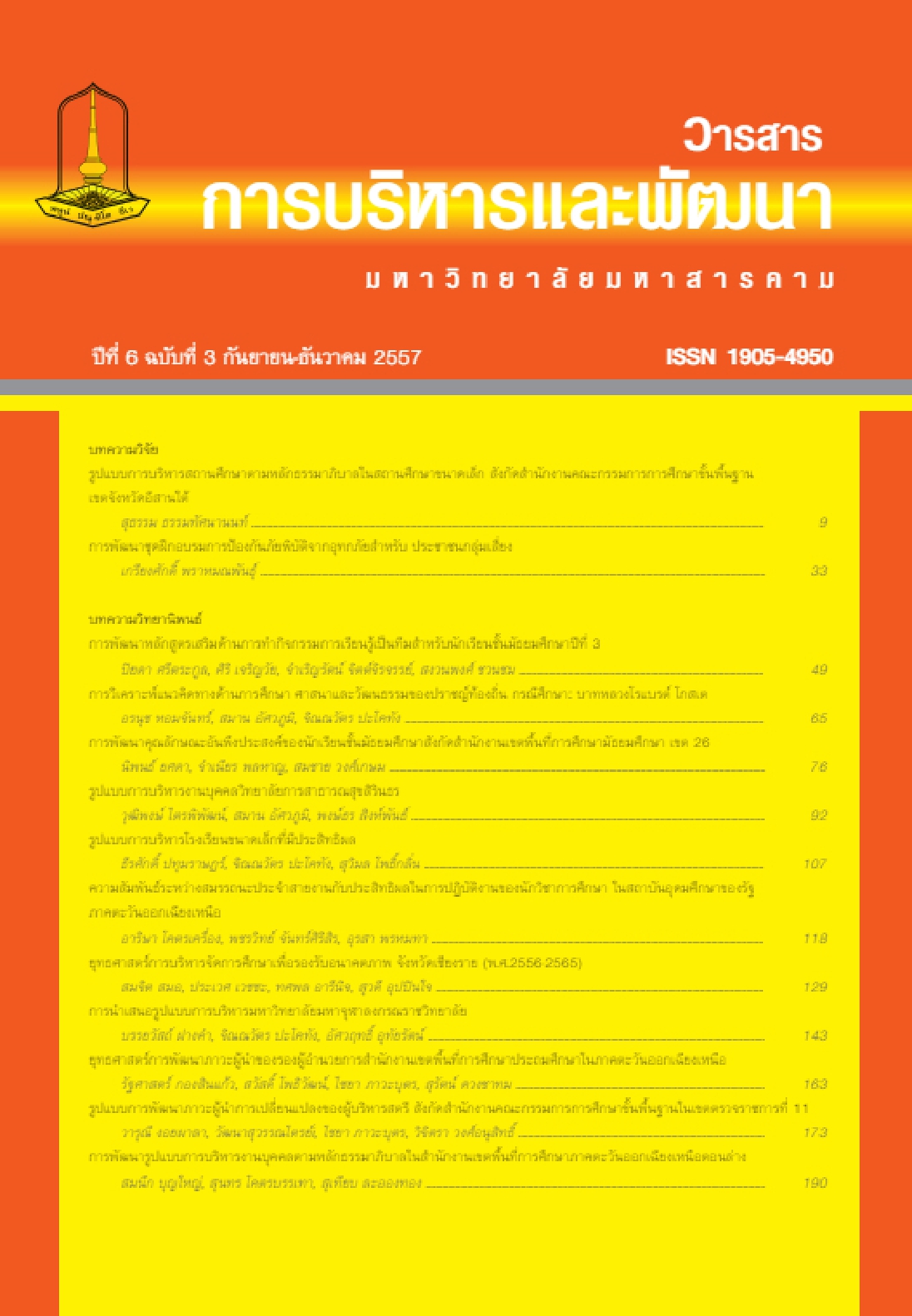A model For Transformational Leadership Development Of Female Administrators Under The Office Of The Basic Education Commission In The Educational InspectionRegion 11
Main Article Content
Abstract
The purposes of this research were to: 1) investigate components of transformational leadership of female administrators under the Office of the Basic Education Commission, in the Educational Inspection Region 11, 2) construct and develop a model of female administrators’ leadership development, and 3) validate the effectiveness index of the developed model. This research employed a Research and Development approach which was performed in three phases: Phase I related to a model investigation concerning components of transformational leadership of female administrators. This phase was investigated through documents and literature reviews and in-depth interviews with scholars. A 5-rating scale questionnaire was administered to a total of 186 comprising one female administrator and one teacher from each school in the Educational Inspection Region 11 in the 2013 academic year. The obtained data from the questionnaire were analyzed through frequencies, percentage, mean, and standard deviation. Phase II Model Establishment and Confirmation involved a model drafting and further refinement by the experts. Phase III Model Implementation and Conclusion. The samples were 15 female administrators under the Office of Sakon Nakhon Primary Educational Service Area 1 in the 2013 academic year. The statistical analysis involved percentage, mean and standard deviation.
The findings were as follows:1) The components of transformational leadership of female administrators under the Office of the Basic Education Commission, in the Educational Inspection Region 11 comprised six major components and 14 sub-major components as follows: 1) Idealized Influence involved two sub-components: modeling the way, and process challenges, 2) Intellectual Stimulation involved promotion and support of an application of knowledge and competency into practice, and administration and decision making processes, 3) inspirational motivation involved two sub-components: advice and inspiration creation, and moral support for members, 4) Individualized Consideration involved two sub-components: Individualization, and mentoring and support, 5) Self Development involved three sub-components: characteristics of female administrators, relations and communication skills, professional development on research for task improvement, and 6) Instructional leadership involved three sub-components: instructional development and planning, curriculum management, and innovation and technology development. The findings also revealed that there were 60 key indicators of transformational leadership of female administrators.
2) The developed model comprised principles, objectives, contents, procedure, media and learning resources, measurement and evaluation. The development process was divided into four stages: Stage I A Two-day workshop, Stage II A Best Practice Visit, Stage III An Actual Practice. The six components were implemented with a total of 18 hours, three hours a day, three times per week for two weeks. Stage IV was related to supervision, monitoring, and assessment.
3) The model had efficiency. As after the model implementation, the mean scores of female transformational leadership development at the monitoring period was higher than that of the pre-intervention stage and the time of the training in actual practice setting. This would conclude that the developed model of transformational leadership of female administrators under the Office of the Basic Education Commission, in the Educational Inspection Region 11 was effective and efficient to be feasible in actual settings.
Downloads
Article Details
References
กัลยา กิตติธาดากุล. (2544). การยอมรับบทบาทของผู้นำ สตรีด้านการปฏิบัติงานในองค์การราชการจังหวัดขอนแก่น. วิทยานิพนธ์ ศศ.ม. ขอนแก่น: มหาวิทยาลัยขอนแก่น.
ฉันทวรรณ ยงค์ประเดิม. (2545). ปัจจัยที่มีความสัมพันธ์กับการยอมรับบทบาทสตรีในการเป็นผู้นำทางการบริหาร. กรุงเทพฯ: มหาวิทยาลัยเกษตรศาสตร์.
ดุสิต สมศรี. (2553). การพัฒนาภาวะผู้นำ การเปลี่ยนแปลงของผู้บริหารสถานศึกษาสังกัดสำนักงานเขตพื้นที่การศึกษาศรีสะเกษ เขต 1. เข้าถึงได้จาก http://www.surasitkalasin2.com/index.php?lay
บุญโสม ดีเลิศ. (2550). การศึกษาภาวะผู้นำการเปลี่ยนแปลงของผู้บริหารสถานศึกษาขั้นพื้นฐาน สังกัดสำนักงาน เขตพื้นที่การศึกษาสุรินทร์ เขต 1.วิทยานิพนธ์ ค.ม. สุรินทร์.มหาวิทยาลัยราชภัฏสุรินทร์.
ประวิตร โหรา. (2551). คุณลักษณะผู้นำของผู้บริหารหญิงตามทัศนะของบุคลากรมหาวิทยาลัยเทคโนราชมงคลรัตนโกสินทร์. ปริญญานิพนธ์ กศ.ด. กรุงเทพฯ: มหาวิทยาลัยศรีนครินทรวิโรฒ.
วรรณดี เกตแก้ว. (2552). การศึกษาองค์ประกอบคุณลักษณะของผู้นำสตรีทางการศึกษาในภาคใต้. ปริญญานิพนธ์ กศ.ม. กรุงเทพฯ: มหาวิทยาลัยศรีนครินทรวิโรฒ.
สมคิด สกุลสถาปัตย์. (2552). รูปแบบภาวะผู้นำการเปลี่ยนแปลงที่มีประสิทธิผลในการปฏิรูปการศึกษาแบบยั่งยืน. วิทยานิพนธ์ ศศ.ด. กรุงเทพฯ: มหาวิทยาลัยศิลปากร.
สุดาวรรณ ศรีสิงห์พันธุ์. (2549). ปัจจัยการบริหารที่ส่งผลต่อประสิทธิผลการบริหารงานของผู้บริหารสตรีในสถานศึกษาสังกัดสำนักงานเขตพื้นที่การศึกษาสกลนคร. วิทยานิพนธ์ค.ม. สกลนคร: มหาวิทยาลัยราชภัฏสกลนคร.
อุดม สิงโตทอง. (2550). การศึกษาภาวะผู้นำ การเปลี่ยนแปลงของผู้บริหารสถานศึกษา สังกัดสำนักงานเขตพื้นที่การศึกษาชลบุรี เขต 2.วิทยานิพนธ์ กศ.ม. ชลบุรี: มหาวิทยาลัยบูรพา.
Coleman, Marianne. (2000). “The Female Secondary Headteacher in England and Wales: Leadership and Management Styles”. Educational Research. 42(1):13-27, January.
Delf, George:&Smith, Bryan. “Strategies for Promoting Self Developmen”. Emerald Backfiles. 494-501,2007.
Heller, Trudy. (1982). Women and Men as Leaders: in Business, Educational and Social Service Organizations. New York: Praeger.
Oplatka, Lzhar. (2007). “Women in Educational Administration within Developing Countries: Towards a New International Research Agenda”. Journal of Educational Administration. 44(6): 604-624. Retrieved January 20 , 2007, from http:// www.emeraldinsight.com.
Pedler, Mike. (1988). “Applying Self-Development in Organization.” ICT. 19-22, March-April.


